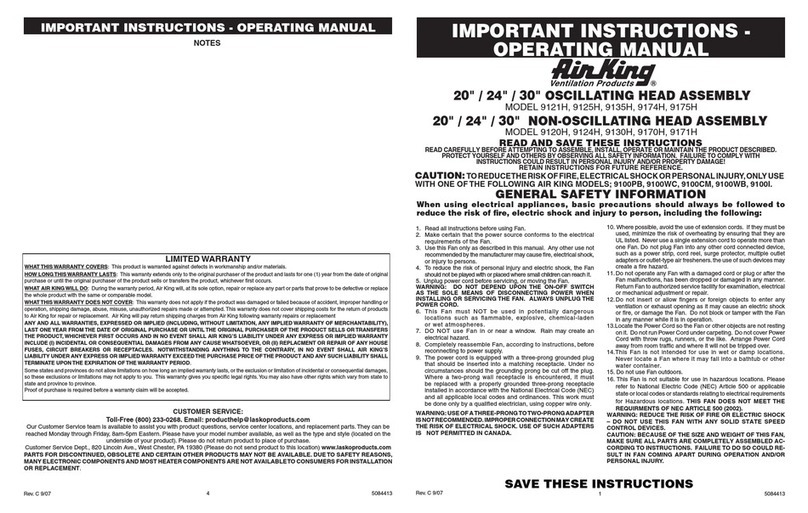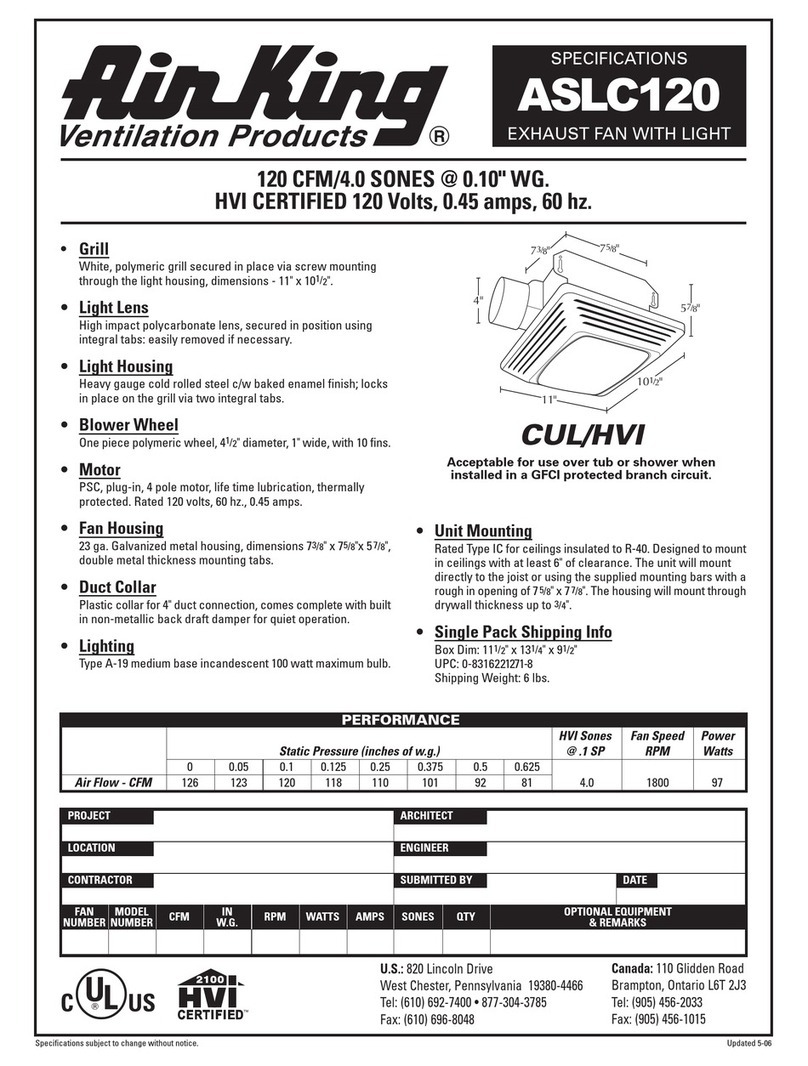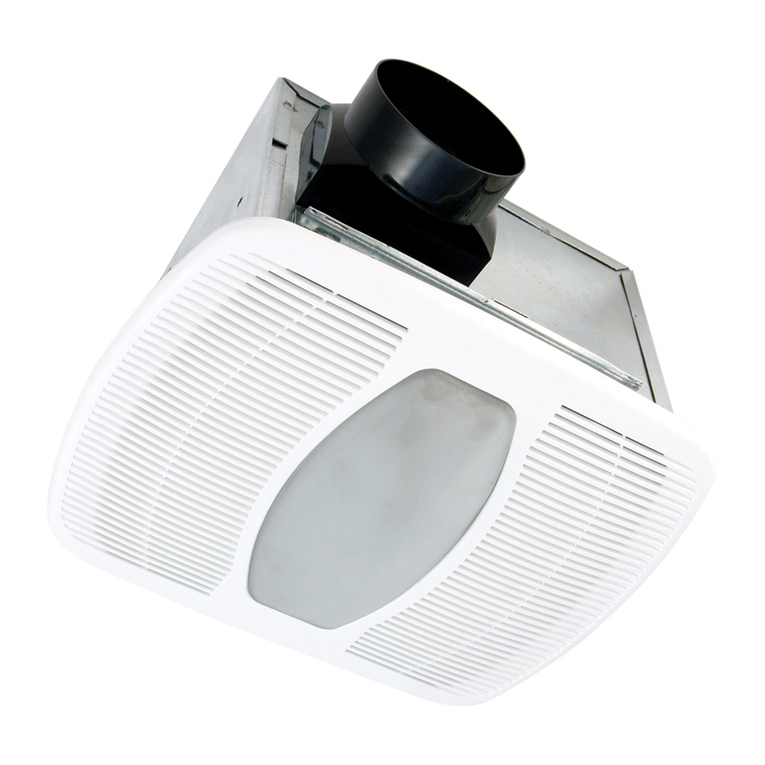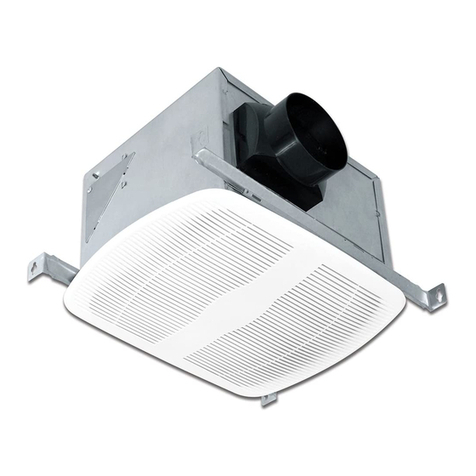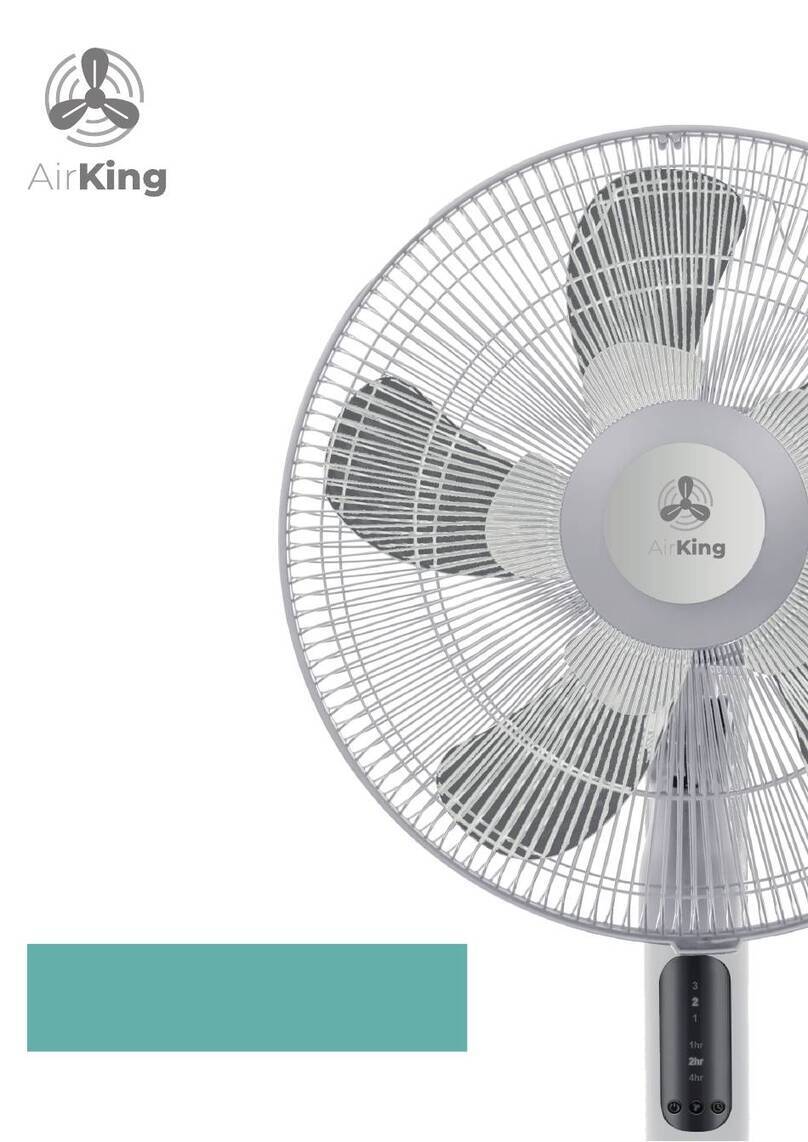
www.airkinglimited.com
A210952011 Rev. L 1-23 3 of 4
1b. Compartiment de Câblage Intérieur: Enlever le vis retenant en place
l’ensemble venturi du ventilateur et soulever pour sortir l’assemblage
hors du châssis (Figure 7). Enlever la vis du couvercle du compartiment à
câblage et mettre ce couvercle dans un endroit fiable (Figure 8).
REMARQUE : Si le raccord du moteur de ventilateur est raccordé au
réceptacle du châssis, le débrancher afin que l’ensemble venturi du
ventilateur soit complètement enlevé.
2a. Ventilation continue: Pour les ventilateurs à deux vitesses,
raccordés pour une ventilation continue. Connectez le fil blanc du
ventilateur au fil blanc (neutre) de la source d’alimentation. Connectez
le fil de terre de la maison au fil vert du boîtier du ventilateur.
Connectez le fil noir du ventilateur au fil noir (chaud) de la source
d’alimentation. Utilisez un interrupteur à bascule standard duplex, correctement
mis à terre, pour relier le fil jaune chaud du ventilateur à l’entrée de l’interrupteur.
Connectez le deuxième fil jaune du ventilateur au côté de sortie du commutateur.
Fermer l’interrupteur changera la vitesse de normale à haute vitesse (Figure 9).
2b. Ventilation intermittente: Pour les ventilateurs à deux vitesses, raccordés
pour une ventilation intermittente avec un interrupteur à bascule duplex standard
(comme Leviton 5224 -2W non inclus). Connectez le fil blanc du ventilateur au fil
blanc (neutre) de la source d’alimentation. Connectez le fil de terre du ventilateur au
fil de terre de la source d’alimentation. Mettez à terre les interrupteurs
correctement. Connectez le fil noir de la source d’alimentation à un
côté de l’interrupteur. Connectez le fil noir du ventilateur à l’autre côté
de l’interrupteur. Connectez 1 fil jaune du ventilateur à chaque côté
de l’interrupteur. Le commutateur avec les connexions noires met le
ventilateur en marche et arrêt. Le commutateur avec les connexions
jaune change la vitesse entre haute et basse (Figure 10).
REMARQUE : L’unité doit être mise à terre selon tous les codes locaux
et nationaux.
3. Réinstallez la couverture du compartiment du fil et le venturi du
ventilateur en suivant les instructions à la réverse à l’étape 1b de la
section 5 du câblage. Assurez-vous que tous les fils sont contenus à
l’intérieur du compartiment du fil.
SECTION 6
Complétion de l’installation
1. Il est recommandé d’utiliser un scellant approprié pour le contact
avec les matériaux de construction actuels et pour les besoins de la
température de l’installation, afin d’empêcher les fuites d’air à partir
des espaces non conditionnés. S’il y a des grands écarts entre le boîtier
de l’appareil et le plafond, du matériel supplémentaire (tige de support,
matériel de plafond) peut être nécessaire.
REMARQUE : Ce ventilateur est conçu pour le contact d’isolation
directe (type IC). Il est aussi recommandé que ce ventilateur soit
complètement recouvert par l’isolation afin de réduire la perte de
chaleur ou de gagner de l’espace inconditionné.
2. Brancher le cordon à raccordement rapide dans le réceptacle. Ce
cordon ne s’ajuste que d’une seule façon dans le réceptacle (Figure 11).
3. Installer la grille en pressant ensemble les deux extrémités des ressorts
et en les installant dans les fentes du châssis du ventilateur. Pousser la
grille en position (Figure 11).
4. Restaurer l’alimentation et tester votre installation.
SECTION 7
Réglage de l’humidostat (Modèle AK100DH seulement)
Ce ventilateur peut être équipé d’un capteur d’humidité qui allume automatiquement
le ventilateur (ou hausse la vitesse pour les modèles à deux vitesses), lorsque
l’humidité est supérieure au point de consigne (ou baisse la vitesse pour les modèles
à deux vitesses) lorsque l’humidité est inférieure ou égale au point de consigne. Si
le ventilateur fonctionne trop longtemps ou pas assez, vérifiez d’abord le point de
consigne du capteur d’humidité. Dans le cas où le niveau d’humidité ambiante de
la pièce s’élève plus haut que le niveau préréglé, le ventilateur s’allumera, même si la salle n’est pas
occupée. Ceci aide à éviter les conditions qui mènent à la croissance de moisissures.
ATTENTION : VOUS ASSURER QUE L’ALIMENTATION EST COUPÉE
AU PANNEAU DE SERVICE AVANT DE COMMENCER L’INSTALLATION.
1. Pour régler le niveau désiré d’humidité de la salle, enlevez la grille et localisez le cadran de
l’humidostat situé sur le couvercle du compartiment de fil.
2. Réglez le cadran à l’humidité relative que vous vous voulez que le ventilateur maintienne,
habituellement entre 50% et 80%. Les climats humides exigeront des réglages plus élevés que les
climats secs. Lorsque le niveau d’humidité de la salle est inférieur à ce réglage, le ventilateur restera
éteint (ou baisse la vitesse pour les modèles à deux vitesses). Lorsque le niveau d’humidité monte
à ce réglage, le ventilateur s’allumera (ou hausse la vitesse pour les modèles à deux vitesses) et
fonctionnera jusqu’à ce que le niveau d’humidité tombe au-dessous de ce réglage.
3. Réinstaller la grille et rétablir le courant.
SECTION 8
Utilisation et entretien
ATTENTION : VOUS ASSURER QUE L’ALIMENTATION EST COUPÉE
AU PANNEAU DE SERVICE AVANT DE COMMENCER L’INSTALLATION.
1. Nettoyage de la grille : Retirer la grille et utiliser un détergent doux, tel que du liquide pour la
vaisselle, puis sécher à l’aide d’un chiffon doux. NE JAMAIS UTILISER D’ABRASIF OU DE POUDRE À
RÉCURER. Sécher complètement la grille avant de la réinstaller. Pour réinstaller la grille, vous référer
à la Section 6 Complétion de l’installation.
2. Nettoyage de l’assemblage du ventilateur : Nettoyer toutes les parties à l’aide d’un chiffon
sec ou passer délicatement l’aspirateur sur le ventilateur. NE JAMAIS IMMERGER LES PARTIES
ÉLECTRIQUES DANS L’EAU.
1b. Internal Wire Compartment: Remove the screw holding the venturi
in place. Lift the venturi up and at an angle to slide it out of the
housing (Figure 7). Remove the wire compartment cover screw and
place the cover in a secure place (Figure 8).
NOTE: If the fan motor plug is connected to the fan housing receptacle,
unplug so the blower assembly can be completely removed.
2a. Continuous Ventilation: For two speed fans wired for continuous
ventilation, connect the White wire of the fan to the White (Neutral) wire
from the power source. Connect the ground wire from the house to the
green wire from the fan housing. Run 2 wires from a properly grounded
wall switch (not included) to the fan. Connect the Black wire of the fan
to the Black wire (Hot) from the power source. Connect the Hot Yellow
wire from the fan to the input of the switch. Connect the second Yellow wire from the
fan to the output side of the switch. Closing the switch will change from normal to
high speed (Figure 9).
2b. Intermittent Ventilation: For two speed fans wired for intermittent ventilation with
a standard duplex toggle switch (such as Leviton 5224-2W not included). Connect
the White wire of the fan to the White (Neutral) wire from the power source.
Connect the ground wire from the fan to the ground wire from the power source.
Properly ground the switches. Connect the black wire from the supply to one side
of the top switch. Connect the black wire from the fan to the other
side of the top switch, Connect 1 yellow wire from the fan to each
side of the bottom switch. The top switch turns the fan On & Off, the
bottom switch changes speed between high and low (Figure 10).
NOTE: Unit must be grounded according to all local and national codes.
3. Reinstall both the wire compartment cover and the fan’s venturi by
reversing the instructions in Step 1b of Section 5 Wiring. Make sure
all wires are contained within the wire compartment.
SECTION 6
Completing the Installation
1. Use a sealant appropriate for contact with the building materials
present and for the temperature requirements of the installation to
prevent air leakage from unconditioned spaces is recommended. If
gaps between unit housing and ceiling are great, additional material
(backing rod, ceiling material) may be required.
NOTE: This fan is rated for direct insulation contact (Type IC) and it is
recommended that this fan be completely covered by insulation in order
to reduce heat loss or gain to unconditioned space.
2. Plug the fan’s quick connect motor cord into the receptacle. This
cord will only fit one way into the receptacle (Figure 11).
3. Install the grill by squeezing the two ends of the springs together
and installing them up into the slots on the fan’s housing. Push the
grill up into position (Figure 12).
4. Restore power and test your installation.
SECTION 7
Setting the Humidistat (Model AK100DH Only)
This fan may be equipped with a humidity sensor that automatically turns the fan on
(or to high speed on dual speed models) when humidity is above set point and off (or
back to low speed on dual speed models) when humidity is at or below set point. If
the fan is operating too long or not enough, first check to see the humidity sensor set
point. In cases where the ambient humidity level of the room rises higher than the
preset level, the fan will turn on even if the room is not occupied. This helps prevent
conditions that lead to mold growth.
CAUTION: MAKE SURE POWER IS SWITCHED OFF
AT SERVICE PANEL BEFORE SERVICING THE UNIT.
1. To set the desired humidity level of the room, remove the grill and locate the
dehumidistat dial located on the wire compartment cover.
2. Set the dial to the relative humidity you want the fan to maintain usually between 50 & 80%. Moist
climates will require higher settings than dry climates. When the humidity level of the room is below
this setting the fan will remain off (or low speed on dual speed models). When the humidity level
rises above this setting the fan will turn on (or to high speed on dual speed models) and run until the
humidity level falls below this setting.
3. Reinstall the grill and restore power.
SECTION 8
Use and Care
CAUTION: MAKE SURE POWER IS SWITCHED OFF AT SERVICE PANEL
BEFORE SERVICING THE UNIT.
1. Cleaning the Grill: Remove grill and use a mild detergent, such as dishwashing liquid, and dry with
a soft cloth. NEVER USE ANY ABRASIVE PADS OR SCOURING POWDERS. Completely dry grill before
reinstalling. Refer to instructions in Section 6 Finishing the Installation, to reinstall grill.
2. Cleaning the Fan Assembly: Wipe all parts with a dry cloth or gently vacuum the fan. NEVER
IMMERSE ELECTRICAL PARTS IN WATER.
Plug
Raccord
Figure 7
Venturi
Screw
Vis
Wire Compartment
Cover
Couvercle du
Compartiment
de Câblage
Figure 8
Screw
Vis
Switch / Commutateur
(by others) / (par d’autres)
Figure 9
Supply from house
Alimentation provenant
de la résidence
Neutral (White)
Neutre (Blanc)
Ground (Green or Bare)
Mise à la terre (vert ou nu)
Fan / Ventilateur
Green / Vert
Black / Noir
By others / Par d’autres
Neutral (White) / Neutre (Blanc)
Yellow / Juane
Yellow / Juane
Black / Noir
Switch
(by others)
Commutateur
(par d’autres)
Figure 10
Supply from house
Alimentation provenant
de la résidence
Neutral (White)
Neutre (Blanc)
Ground (Green or Bare)
Mise à la terre (vert ou nu)
Fan / Ventilateur
Green / Vert
Black
Noir
By others / Par d’autres
Neutral (White) / Neutre (Blanc)
Yellow / Juane
Black / Noir
Yellow / Juane
Screw
Vis
Wire Compartment
Cover
Couvercle du
Compartiment
de Câblage
Figure 11
Figure 12




